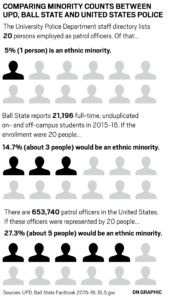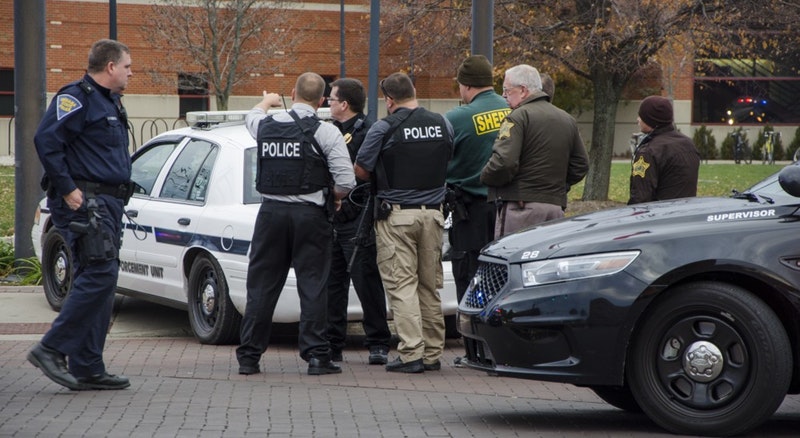INCREASING DIVERSITY in police departments has been a slow, but gradual process for decades.
In hundreds of police departments across the country, the percentage of white officers on the force is more than 30 percentage points higher than in the communities they serve, according to an analysis of a government survey of police departments.
Ball State’s University Police Department is one of many that still sees a high majority of white, male officers on the force.
In UPD, 10 percent of officers are of ethnic minorities, which is nearly 5 percentage points lower than the 14.7 percent of students of an ethic minority at Ball State, according to the factbook.
“Just like all other departments at Ball State, UPD is committed to the principles of nondiscrimination and equal opportunity in employment,” UPD’s chief Jim Duckham said in an email. “We are committed to the pursuit of excellence by being inclusive of all individuals.”
Police departments are working to seek more minorities and women, and many agencies are actively and aggressively recruiting these demographics.
According to the Bureau of Justice Statistics:
- Racial and ethnic minorities in state and local agencies made up 27.3 percent of full-time sworn personnel in 2013, up from 23.6 percent in 2003
- Women accounted for about 12 percent of officers in 2013 up from 7.6 percent in 1987
Experts say diversity in the police force increases a department’s credibility with its community, according to BJS findings.
 Bruce Henry, manager for the Indianapolis Metropolitan Police human resources office and chapter president of the National Organization of Black Law Enforcement Executive (NOBLE), said there isn’t any reason why there are limited numbers of minorities in police departments.
Bruce Henry, manager for the Indianapolis Metropolitan Police human resources office and chapter president of the National Organization of Black Law Enforcement Executive (NOBLE), said there isn’t any reason why there are limited numbers of minorities in police departments.
“I think there is an attitude of ‘if it ain’t broke, don’t fix it’ — there’s not enough proactive engagement to bring minorities into these departments,” Henry said.
Henry said many police departments today aren’t good at making the job of police officers more enticing to minorities, and more obstacles — like education requirements, health and fitness requirements — are not focused on minority candidates.
“You can recruit thousands of ethnic minorities, but if the exam has bias built into it, then the exam is going to exclude some groups,” Henry said. “And that’s why our organization tries to assist law enforcement to ensure they reach out to ethnic minorities.”
Despite being below national minority police statistics, UPD is relatively reflective of Ball State’s student population.
But Henry said agencies shouldn’t necessarily only look for officers who mirror their communities. From this perspective, Henry said diversity can include religion, sexual orientation, age, family background or occupation, and even neighborhoods or high schools.
“If my worldview is one thing, and the person I encounter has a different worldview than I do, that’s something officers are going to need to know how to deal with,” Henry said. “But crime is not limited to just one population of people, just as the world isn’t limited to a certain type of person.
“Yes, we need officers that represent the demographic of the population in the area, but don’t abandon the minority and the officers that are also capable of helping the community grow and be the best it can be.”
The Department of Justice and the Equal Opportunity Employment Commission said in its annual law enforcement diversity review that all aspects of diversity should be considered when jurisdictions are looking at if their law enforcement agencies are representative and reflective of the communities they serve.
Since the Law Enforcement Management and Administrative Statistics Survey in 1987, the employment of female officers has increased in all population categories, but larger jurisdictions have continued to employ females at a higher rate.
- In 2013, approximately 58,000 females worked as local police officers. Only 27,000 did so in 1987
UPD currently employs nine women, of which two are assigned as patrol officers. UPD’s percentage of women patrol officers (10 percent) is also below the national average (12 percent).
IMPORTANCE OF DIVERSITY
Diversity can be a crucial element in establishing and expanding trust between law enforcement and the community.
But police force diversity is not something achieved without firm commitments from the police chief and top police administrators to make it a priority, according to the John F. Kennedy School of Government at Harvard University.
Outsiders like human rights commissioners, district attorneys and city officials can provide valuable support to encourage a police department to undertake efforts to achieve and maintain diversity, but this support is no substitute for leadership at the top.
A lack of diversity would be contrary to some of the U.S.’s most fundamental civil rights laws and protections, according to Increasing Diversity in Police Departments: Strategies and Tools for Human Rights Commissions and Others at Harvard Law.
Title VII of the Civil Rights Act of 1964 prohibits employment discrimination on the basis of race, sex, color, religion, and national origin. It also prohibits the use of neutral selection practices that fall more heavily on one group unless those practices have been shown to be job related and consistent with business necessity.
“Diversity is something that is appeasing. I’m not suggesting we discontinue, but I think that engagement is the best circumstance,” Henry said. “You can preach to a class about surrounding yourself and accepting people that are unlike you, but you have to actually do it — you have to be diligent about it — and it’s really hard work.”
This is something UPD does by stressing the education and implication of diversity education for its officers and staff, Duckham said.
“Our officers are right here, available to go anywhere at anytime, and not just simply for emergency runs, which are, of course, critical to the work we do,” Duckham said. “But our officers have also been a part of numerous panel discussions and other events designed to build relationships, and we welcome any opportunity to continue to do more of those types of things.”
The best way to build relationships is by getting people together so they can see each other as unique, dedicated individuals all committed to the same goal, he said. Department members participate in training on topics like cultural diversity, bias incidents, hate crimes and racial profiling.
“It is important that police understand the community’s concerns and perspective on important topics, such as race relations,” Duckham said. “The police should be seen as members of the community, and that is what we strive for at Ball State.”
